Last weekend, I sent a bonus post to paid subscribers with a story about friendships and showing up for each other through tough times, and an update on a major project. If you’d like to receive the occasional bonus post plus an invitation to the monthly online meetup, please consider upgrading your subscription to the supporter level. Our next group chat via Zoom is Tuesday, February 18, 5 p.m. Mountain.
Ordinarily, by early February, I would’ve run this plowed dirt road so many times during the season that I’d hardly notice its undulating hills, bare aspens, and view of the nearly 13,000-foot Sunshine Mountain. A go-to winter route, which typically has a thin layer of packed snow—icy in spots, melted in others—it’s so familiar that I traverse it on autopilot, absorbed in thoughts or a podcast against the rhythmic background noise of metal traction tips on shoes hitting and grinding the snow.
Last Saturday, however, I revisited the road for a run for the first time since summer and viewed it with fresh eyes, senses alert. When I reached a blue-tinged ice formation that reappears each December and melts months later, I paused to admire it, awed by the sculpted surface and the sound, like faint wind chimes, of it dripping.
As I ran, I tuned into sensations while self-coaching running form. Pain in injury spot? At first maybe a 2 on the scale to 10, then its stiffness and ache faded until I stopped noticing. Foot fall? Light, quick, landing under my body as I visualized each heel moving up toward my butt for a stride more like pedaling a bike. Arm swing? Pendulum-like, hands gliding hip to chest, no tension in shoulders. Jaw, eyes? Relaxed, upward.
Each time my watched buzzed after a mile, I expressed an inward yes. I got to eight beeps in under 90 minutes, then slowed to a jog, then walked, to cool down until the stopwatch showed 1:30. Ninety whole minutes! My face felt flush with effort, chest heaved, and lower body expressed fatigue but not pain. I’m fairly sure I glowed.
A three-month-long run-stopping injury managed to do what I previously had tried unsuccessfully to achieve as a mental trick: a reset to a beginner’s mindset—the nonjudgemental, joyous frame of mind that cheers rather than criticizes during a run that feels more special than routine.
It likely won’t last. I’ll probably get back to the regular mode of training where the run workouts feel satisfying but task-oriented and tiring. I’ll be less mindful, less appreciative. For now, however, I want to capture and extend the celebratory feeling of a comeback.
Last week was my first week of “real” running, by which I mean it incorporated normal steady runs instead of hikes interspersed with little test-run segments to gauge injury recovery. I ran five miles Monday, four Wednesday, another four Thursday, then the eight on Saturday—a typical beginner’s week.
I can finally start building up, carefully, to get ready for the Quad Rock 50 in 13 weeks and the Hardrock Hundred in 22 weeks.
This time last year, I already was in ultra shape. It’s daunting, but motivating, to start regaining ultra-level fitness with those two races on calendar. (To those who might question, why the rush? Why race those long distances given the injury recovery? The answer is, the Hardrock Hundred took me a decade to gain a spot and doesn’t allow injury deferrals—so this July is my one shot—and I need the 50-miler in May as a key peak training run for it.)
If I look at stats from a week in late January one year ago versus from last week (below), I see my CTL or “chronic training load”—a measure of longer-term fitness—was at 163 then compared to only 50 now. I was running 10+ hours versus last week’s four, logging 50 miles instead of 20ish.

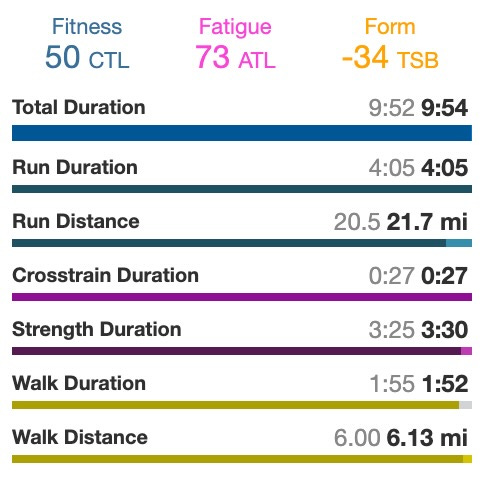
I look at last week’s stats, seen on the right above, and feel proud about the balance—the gym time, hiking, and bit of yoga (logged as cross-training) mixed in with the running—and it feels healthy. I also feel a blend of intimidation and determination about the volume buildup I face this spring.
I’m trying not to feel self-conscious and concerned about my training compared to others heading toward Hardrock—trying to avoid comparisons, period—and tune into the feelings of freshness and motivation that are part of a beginner’s mindset. By contrast, a year ago in early February, I suffered burnout while competing in a 12-hour wintertime ultra with laps up and down a snowy steep mountain, and experienced disappointment and bone-weary fatigue, as chronicled here:
Injury has been difficult, to put it mildly, to deal with since November. And I’m still not 100 percent healed; the injury spot (at the head of the tibia, where the IT band attachment partially detached) still “talks to me” off and on in the form of mild aching, and a secondary soreness in my glute recently flared. Maintaining an older body with high mileage on its internal odometer is like fixing and constantly tinkering with an old car to keep it running. But I’m feeling better, stronger, and wiser coming out of this downtime.
It’s one of those “good news, bad news, hard to tell” situations I wrote about recently. My plan had been to start this year with training for an early-March road marathon, to build my cardio engine and work on speed before transitioning to slower high-country mountain training this spring. As soon as the MRI results showed a torn tendon, I scratched the marathon plans. Good news, bad news? Who knows, marathon training at the start of this year may have led to burnout or injury heading into training for summer’s mountain ultras.
The point of all this is that in the face of a big setback, it helps (but I know is hard) to be flexible, adaptable, and embrace the fresh start of a comeback. Try to hold onto the feelings of renewed gratitude and discovery that come from starting over after time off, and give yourself grace as if you were a rookie beginner rather than a rusty old pro.
I’m going to camp! Join me there?
I’m craving the warmth and beauty of the desert, plus camaraderie and support as I rebuild fitness and increase run volume, so I just signed up for a women’s trail-running camp in Sedona that starts one month from today. A couple of spots are still open, so I hope you’ll visit the site and consider going.
I chose this camp largely because my friend Cristal organizes and coaches at it, and she’s great.
Last year, I wrote about the benefits of a retreat. Going to camp for writing or running has been one of the greatest gifts I’ve given myself. Yes, it’s expensive and takes precious time that might otherwise be spent on a family trip or working, but I have always felt this “me time” combined with supportive company is profoundly fulfilling and worth it, no regrets.
If this Sedona camp doesn’t work for you, check out their other trail-running retreats offered during the year. And if you’re a writer/creative plus runner, I recommend checking out camps organized by a writer/runner I admire:
’s flow camps. I have not attended hers but bet it’s great. Her early September one takes place in the Lizard Head Wilderness near where I live.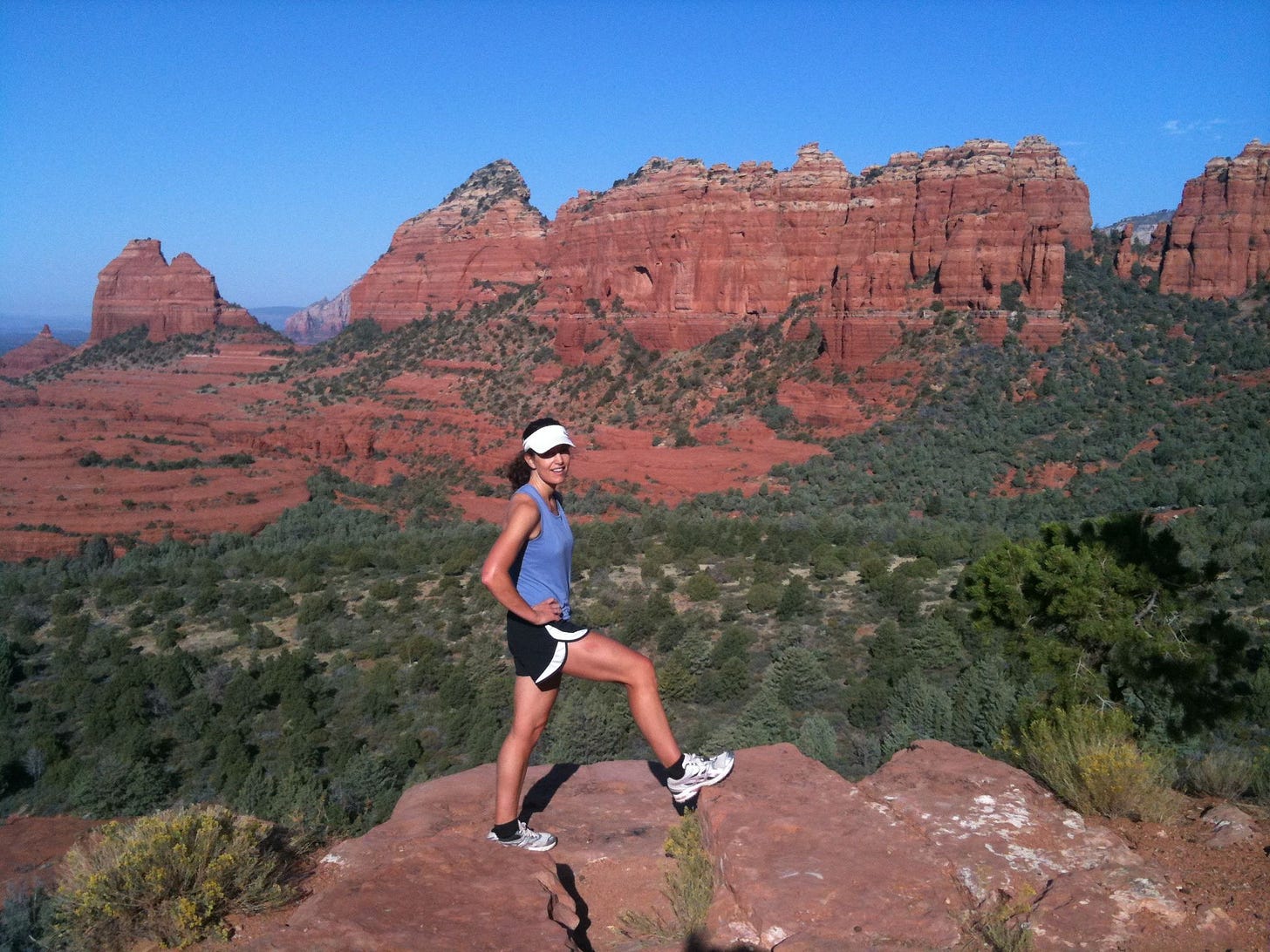
A tip for cadence
As I relearn how to run steadily, I’m working on quicker, lighter turnover with a fuller stride (instead of defaulting to the leaden “ultra shuffle”). Music helps achieve this.
Did you know you can search Spotify for a playlist for beats-per-minute (bpm)? There’s no way I can run now with a cadence as quick as the standard recommended 180 bpm, and even 170 bpm feels too fast when running hills with packed snow on shoes with traction devices. But 160 to 165 feels about right. Listening to a Spotify playlist with songs that have this bpm, and running in rhythm to the beat, helps me run better and find a groove. Plus, the playlist surprises me with a diverse mix of songs, e.g. the Dead’s “Touch of Grey” juxtaposed with Taylor Swift’s “Shake It Off.” It’s fun! Try it, just type 170 bpm or whatever number + bpm in the Spotify search bar.
Recommended reading related to this post:
- writes about the psychological pain and withdrawal symptoms from running due to injury in “Clipped Wings.”
Coach
writes in this Morning Shakeout newsletter post about a hard reset going into 2025 after feeling “like I was tolerating my training but not absorbing it, while muscling my way through races that I just really didn’t want to run.”
If you’d like to support this newsletter but would rather not commit to a year-long paid subscription, please consider donating a small tip to my virtual tip jar.



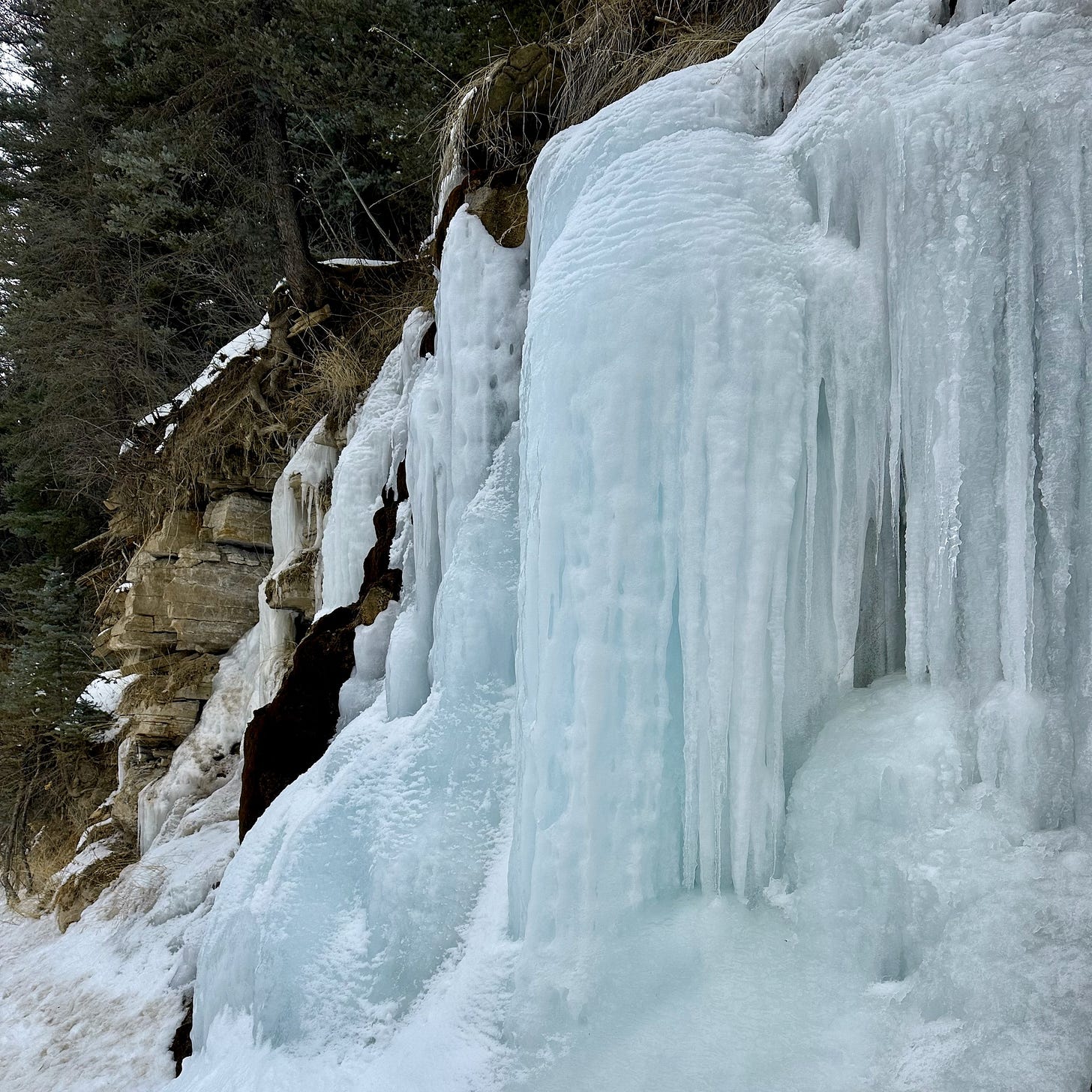
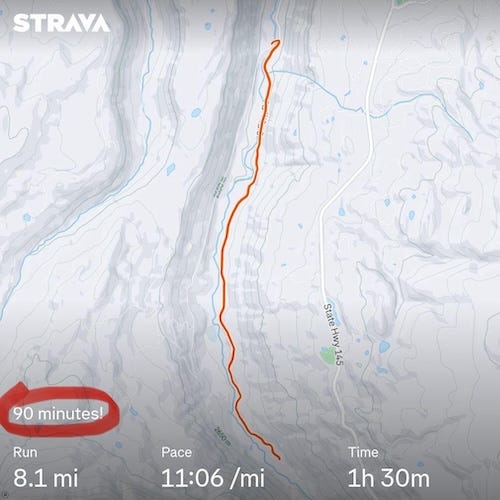
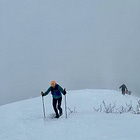
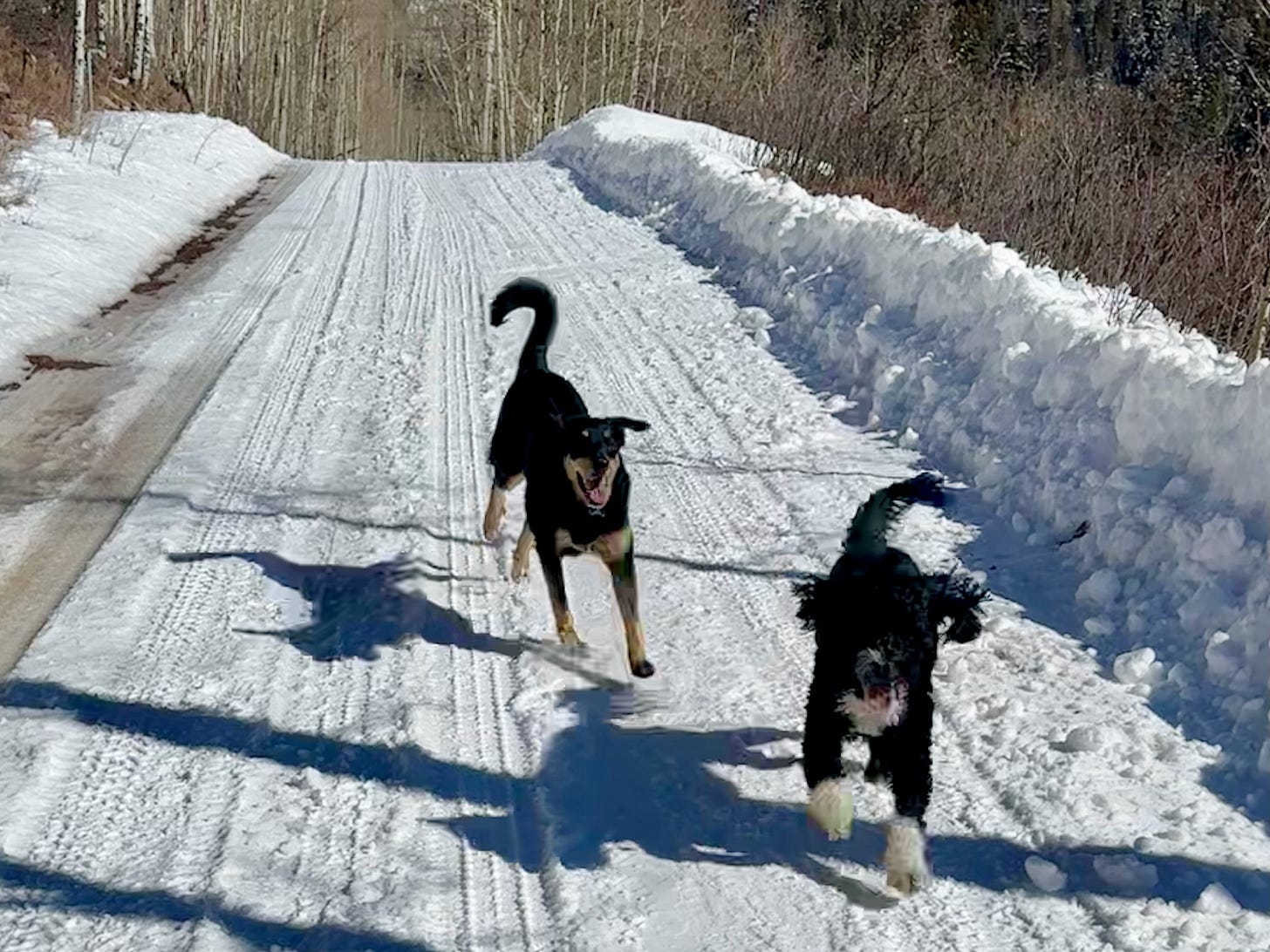


Glad you are literally back up and running again! To borrow from Eliud Kipchoge: Take it slowly by slowly. (And thank you for linking to this week's shakeout.)
What a great post and reminder. I would so love to hit a running camp at some point but it’s flu season so not much chance of a string of days off in a row any time soon. I hope the recovery journey continues to go well and the sense of wonder lasts. I had a very strange dream the other night. I won’t bore with the details but I woke up remembering that I wished I had better appreciated the feeling of warm grass on bare feet. ❤️still hoping for my first ultra this year. Good luck out there